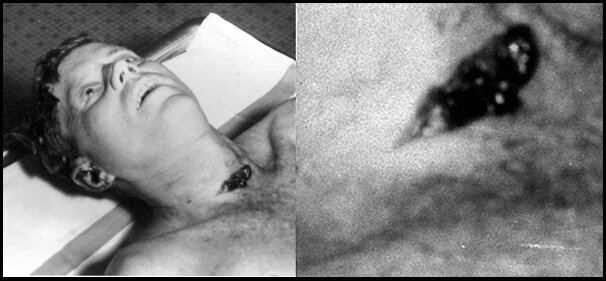
Two of the first doctors to arrive at trauma room one at Parkland Memorial Hospital, Drs. Charles Carrico and Malcolm Perry, described the throat wound as having the characteristics of an entry wound: small and circular. Dr. Carrico said it was "probably a 4- to 7-mm wound...rather round...no jagged edges..." [2]. Dr. Perry described it as about "5 mm" and "roughly spherical to oval in shape, not a punched out wound..." [3].
Dr. Perry made an incision across the bullet wound, just large enough to accommodate a breathing tube. During a phone conversation in 1966 with author David Lifton, Perry said the incision was "two to three centimeters" wide [4, p. 272]. Drs. Paul Peters and Robert McClelland, also present in trauma room one, said the incision was "sharp" and "smooth," respectively [4, p. 275]. After the breathing tube was removed, the incision closed, revealing the original wound in the throat, as described by Drs. Charles Crenshaw and Malcolm Perry. Dr. Crenshaw recalled, "When the body left Parkland there was no gaping, bloody defect in the front of the throat, just a small bullet hole in the thin line of Perry's incision" [5, p. 54] Dr. Perry described the bullet wound in the throat as "inviolate" [6, pp. 100-101].
In stark contrast, when the president's body was observed at the Bethesda Naval Hospital at 8:00 pm -- the start of the official autopsy -- the incision/wound in the throat was elongated and widened. The autopsy report [1, p. 540] described it as "a 6.5 cm long transverse wound with widely gaping, irregular edges." In his testimony to the Warren Commission, chief pathologist Dr. James Humes said that it was "7 or 8 cm" in the transverse direction [7] (Figure 1).

Figure 1. The "stare of death" photograph.
http://www.blogger.com/blogger.g?blogID=2179559648623532823#editor/target=post;postID=4678276022518905572
JFK 11/22/63:
Where Was the Throat Wound Altered?
by
James V. Rinnovatore
No comments:
Post a Comment